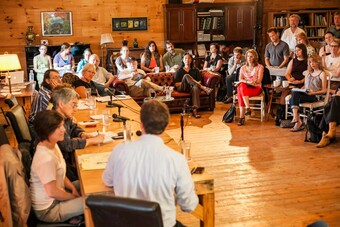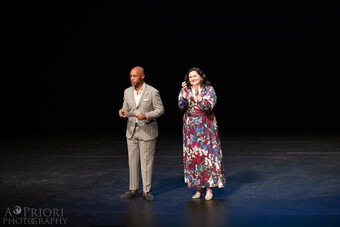Postcards from Romania
Crossing the Audience Border
This four-part series documents the experiences of a young, Fulbright fellow, avidly exploring theater and life in Bucharest, Romania.
During my first, jetlagged week in Romania I sat in a small town production of The Producers. Its book and lyrics had been translated into Romanian, a valiant attempt, but as the play went on the audience around me grew steadily restless. The last chords were sung, the curtain closed and I, about to breath a sigh of relief, had my first experience with an unexpected phenomena. The audience burst into applause, rising to their feet, cheering and calling the actors back out to the stage at least three times. This was the same audience that moments before had been grumbling, walking out, checking their phones and updating their instagram feeds. I sat, dumbfounded, as they clapped for ten minutes, wondering if we had experienced the same show.
I soon found out that this wasn’t unique to that town or theater. Every single show I’ve seen, be it at the National Theater or in someone’s apartment, has ended with these long curtain calls, regardless of show quality, content or the size of the audience. The Romanian audience wants to clap and understanding the history of applause under Communism (simply, they did a lot of it), the roaring praise starts to make sense. Before ’89, theater and actors stood out in a system where keeping your head down meant that you might survive. Theater was one of the only art forms that was able to get around the censors, because the beauty of the live performance was that it couldn’t be controlled night to night. Theater became a place for escapism and subversion and the audience looked for the symbols that would mirror their own anger against the regime (for a much more in depth discussion of the censors, check out Andrea Tompa’s article here). The audience could rebel by applauding, safe in a crowd. But even long after the overthrow of the Communist regime in ’89, theater audiences continue to practice an old ritual in a new system.
I sit in theaters today and I question who this contemporary audience is and if they find themselves represented onstage. The demographics of the audience are different, theater to theater, town to town; the National Theater attracts older audience members who go to be seen, the independent spaces usually play towards a younger crowd, similar to the Broadway, independent, and regional audiences in the US. But the one unifying factor is that the work isn’t made for the audience, it’s made for the artist.
Theater has always been a high art with underlying class and elitist assumptions and if an audience member doesn’t understand the show, then it is their fault. However, the divide between the artists and the audience might in fact be hurting the makers, as young, independent theater artists now rely on ticket sales for their paychecks.
When I try to talk to directors, managers, and actors about who their audience is, the first reaction is dismissal, the descriptor “uneducated” is used and the conversation stops there. Theater makers are taught to look down on their audience, but now that they’re all competing against accessible screens that don’t speak down to audiences, the artist might have to come down the pedestal. The discussion about developing a community or offering audience engagement is just starting to happen, mostly through Boal style community work. But these conversations can’t happen overnight and the Romanian theater artists are just starting to swing from an individual mindset towards a system of companies and community between the creators and the audience.
I have to wonder, do we care too much about comfort and safety?
But here’s the catch. While in Romanian shows, I’ve experienced some of the most intense and exciting audience interactions I’ve ever had. I’ve been spit on, yelled at, thrown in the back of a truck and taken to an unknown location, dodged drips of kerosene as real torches swung above me, been covered in dirt, have had to run to get out of the way of a tar and feathering that happened on top of audience members, and come face to face with my own claustrophobia. I’ve never felt taken care of through these performances; they are a long ways away from the cushy American shows, and things like aisle lights start to feel like a luxury, and I have to wonder, do we care too much about comfort and safety? It’s freeing to not have to worry about the audience, to not rely on their tickets sales and I wonder if this freedom might actually offer more in the long run. Has the American theater lost the sense of danger in live performance, in a world where making sure that everyone feels safe trumps the artistic experiment?
I am wholeheartedly in support of work that creates community between the artists and the audience, theater that gives a gift to its audience. I believe that this is the future of institutional theater in the US, work that cultivates its audience and balances the fine line between work that the audience wants to see and work that the artists want to make. As someone who comes from a small town that really loves A Christmas Carol, I have to believe that I can ask more of my community through the work that they see, that through theater they can be changed, physically, emotionally, and ideologically. So I ask theater makers from both worlds: Romanians, more audience engagement, and Americans, trust that the audience can be pushed a little farther.











Comments
The article is just the start of the conversation—we want to know what you think about this subject, too! HowlRound is a space for knowledge-sharing, and we welcome spirited, thoughtful, and on-topic dialogue. Find our full comments policy here
Great article, as always! Helps me see and understand more of both my Romanian environment as well as the US one!
Thanks Ioana!
Great stuff! Enjoy your time abroad. Go check out some theatre in Sarajevo while you are there.
Thanks! I'm trying to get over there, I hear great things.
Thanks Hanna - a great account of your experience and responses. Much of what I see, and have for over thirty years in my home country, Australia, seems to me threadbarely and/or spuriously connected to the idea of "For Them, With Them".
It's seldom do I hear or read discourse centred on these two notions. Perhaps it is to be expected to be so in the marketed and branded and indentured enterprise that theatre making is today.
The theatre's relationship with the most vital and essential participant( the audience) is the question of our time - and many people are tackling it, in one way or another. The little dictum I've put up here has been something that has been resonant for me for a number of years.
My own struggle with the question of the relationship between what and who is on stage and who is in the audience has lead me a long journey to considering what the theatre has become in "Western" culture since the mid 19thCentury. I seem also to have come to the point where I need to question how we "talk" about the theatre - in theory and practice.
I do know that when I feel the urge leap out of my seat with excitement and delight, that the theatre makers before me are looking to my interests above their own and have "included" me in the making of every moment. Looking forward to reading more. Cheers, Laszlo.
Thanks for the response! I believe that this is a universal question that theatre makers have to explore, the "who is the audience?" and the "why here, why now?" I too am afraid that, especially for the developed world, the Western influence is very strong and I find myself wondering what Romanian theatre would look like, if it didn't have the pressure to be commercial/play outside of Romania. Thanks for the response.